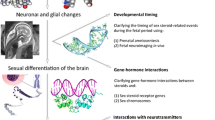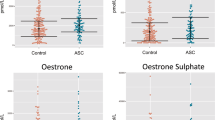Abstract
There is consistent evidence in the literature that the foetal neurodevelopmental period is crucial for the genesis of schizophrenia later in adult life. There are also strong indications that the schizophrenic illness has sexually dimorphic features. A hypothesis consistent with both findings is that sexual hormones may act as aetiological agents for schizophrenia during the foetal period influencing the neurodevelopment in a differential way in males and females. The aim of this study is to verify this hypothesis exploiting the correlation between fingers’ length in adults and hormonal concentrations in utero, which has been demonstrated in previous studies. More specifically, the literature shows that the lengths of the second and fourth finger in adults are proportional to the foetal concentrations of respectively oestrogens and androgens. When the sample of patients suffering from schizophrenia analysed in this study was compared with healthy subjects, it was observed that the average length of the second digit in the female schizophrenic sample resulted significantly shorter than in the female controls. There was no significant difference when the male schizophrenic sample was compared with male controls. The result of the study is, therefore, compatible with the hypothesis that oestrogenic hormones protect female foetuses from damage during the neurodevelopment in utero and ultimately give more benign characteristics to the schizophrenic illness in women.
Similar content being viewed by others
References
Andia AM, Zisook S, Heaton RK (1992) Gender differences in schizophrenia. J Nerv Ment Dis 183:522–528
Andreasen NC, Swayze VW II, Flaum M, Yates WR, Arndt S, McChesney C (1990) Ventricular enlargement in schizophrenia evaluated with computed tomographic scanning: effects of gender, age and stage of the illness. Arch Gen Psychiatry 47:1008–1015
Angermeyer MC, Kuhn L, Goldstein JM (1990) Gender and the course of schizophrenia: differences in treated outcomes. Schizophrenia Bull 16:293–307
Bryant NL, Buchanan RW, Vladar K, Breier A, Rothman M (1999) Gender differences in temporal lobe structures of patients with schizophrenia: a volumetric MRI study. Am J Psychiatry 156: 603–609
Castle D, Sham P, Murray M (1998) Differences in distribution of onset in males and females with schizophrenia. Schizophr Res 33:179–183
Cooper JE, Goodhead D, Craig T, Harris M, Howat J, Korer J (1987) The incidence of schizophrenia in Nottingham. Br J Psychiatry 151:619–626
Fearon P, Lane A, Airie M, McGowan A, Byrne M, Cannon M, Cotter D, Murphy P, Cassidy P, Waddington J, Larkin C, O’Callaghan E (2001) Is reduced dermatoglyphic a-b ridge count a reliable marker of developmental impairment in schizophrenia? Schizophr Res 50:151–157
Filipovic B, Prostran M, Ilankovic N, Filipovic B (2004) Predictive potential of cavum septi pellucidi (CSP) in schizophrenics, alcoholics and persons with past head trauma. A post-mortem study. Eur Arch Psychiatry Clin Neurosci 254:228–230
Garn SM, Burdi AR, Babler WJ, Stinson S (1975) Early prenatal attainment of adult metacarpal-phalangeal rankings and proportions. Am J Phys Anthropol 43:327–332
Goodman Y, Bruce AJ, Cheng B, Mattson MP (1996) Estrogens attenuate and corticosterone exacerbates excitotoxicity, oxidative injury and amyloid beta-peptide toxicity in hippocampal neurons. J Neurochem 5:1836–1844
Gur RE, Turetsky BI, Cowell PE, Finkelman C, Maany V, Grossman RI, Arnold SE, Bilker WB, Gur RC (2000) Temporolimbic volume reductions in schizophrenia. Arch Gen Psychiatry 57: 769–775
Hafner H, Behrens S, De Vry J, Gattaz WF (1991) An animal model for the effects of oestradiol on dopamine-mediated behaviour: implications for sex differences in schizophrenia. Psychiatry Res 38:125–134
Hafner H, Hambrecht M, Loffler P, Munk-Jorgensen P, Riecher-Rossler A (1998) Is Schizophrenia a disorder of all ages? A comparison of first episodes and early course across the life-cycle. Psychol Med 28:351–365
Hafner H, Rircher A, Maurer K, Loffler W, Munk-Jorgensen P, Stromgren E (1989) How does gender influence age at first hospitalisation for schizophrenia? A transnational case register study. Psychol Med 19:903–918
Hass GL, Glick ID, Clarkin JF (1990) Gender and schizophrenia outcome: a clinical trial of an inpatient family intervention. Schizophr Bull 16:277–292
Iacono WG, Beiser M (1992) Are males more likely than females to develop schizophrenia? Am J Psychiatry 149:1070–1074
Iacono WG, Beiser M (1992) Where are the women in firstepisode studies of schizophrenia? Schizophr Bull 18:471–480
Johnstone EC, Owens DG, Crow TJ (1989) Temporal lobe structure as determined by nuclear magnetic resonance in schizophrenia and bipolar affective disorder. J Neurosurg Psychiatry 52:736–741
Kawasaki Y, Suzuki M, Nohara S,Hagino H, Takahashi T, Matsui M, Yamashita I, Chitnis XA, McGuire PK, Seto H, Kurachi M (2004) Structural brain differences in patients with schizophrenia and schizotypal disorder demonstrated by voxel-based morphometry. Eur Arch Psychiatry Clin Neurosci 254:406–414
Keshavan MS, Hogarty GE (1999) Brain maturational process and delayed onset of schizophrenia. Dev Psychopath 11:525–543
Loranger A (1984) Sex differences in age at onset in schizophrenia. Arch Gen Psychiatry 41:157–161
Lyon M, Barr CE, Cannon TD, Mednick SA, Shore D (1989) Fetal neurodevelopment and schizophrenia. Schizophr Bull 15:149–161
Malla AK, Takhar JJ, Norman RM, Machanda R, Cortese L, Haricharan R, Verdi M, Ahmed R (2002) Negative symptoms in first episode of non-affective psychosis. Acta Psychiatr Scand 105:431–439
Manning JT (2002) Digit ratio: a pointer to fertility, behaviour and health. New Brunswick, NJ, Rutgers University Press
Manning JT, Bundred PE (2000) The ratio of 2nd to 4th digit length: A new predictor of disease predisposition? Med Hypotheses 54:855–857
Manning JT, Scutt D, Wilson J, Lewis-Jones DI (1998) The ratio of 2nd to 4th digit length: a predictor of sperm numbers and concentrations of testosterone, luteinizing hormone and oestrogen. Hum Reprod 13:3000–3004
Marenco S, Weinberger DR (2003) Following Ariadne’s double stranded thread through early development: will we ever get out of the labyrinth? In: Stone WS, Faraone SV, Tsuang MT (eds) Early Clinical Intervention and Prevention in Schizophrenia. Humana Press, Totowa, NJ
Munk-Jorgensen P (1986) Schizophrenia in Denmark. Incidence and utilisation of psychiatric institutions. Acta Psychiatr Scand 73:172–180
Murray RM, Lewis SW, Owen MJ, Foerster A (1988) The neurodevelopmental origins of dementia praecox. In: Bebbington P, McGuffin P (eds) Schizophrenia: The major issues
Nopoulos P, Flaum M, Andreasen NC (1997) Sex differences in brain morphology in schizophrenia. Am J Psychiatry 154:1648–1654
Nopoulos P, Flaum M, Arndt S, Andreasen NC (1998) Morphometry in schizophrenia revisited: height and its relation to premorbid function. Psychol Med 28:655–663
Perry W, Moore D, Braff D (1995) Gender differences on thought disturbance measures among schizophrenic patients. Am J Psychiatry 152:1298–1301
Piccinelli M, Gomez-Homen F (1997) Gender differences in the epidemiology of affective disorders and schizophrenia. World Health Organization, Geneva
Roberts GW, Harrison PJ (2000) Gliosis and its implications for the disease process. In: Harrison PJ, Roberts GW (eds) The Neuropathology of Schizophrenia: Progress and Interpretation. Oxford University Press, Oxford
Royas DC, Teale P, Sheeder J, Simon J, Reite M (1997) Sex-specific expression of Heschl’s gyrus functional and structural abnormalities in paranoid schizophrenia. Am J Psychiatry 154: 1655–1662
Salokangas RKR (1983) Prognostic implications of the sex of schizophrenic patients. B J Psychiatry 142:145–151
Seeman MV (1989) Neuroleptic prescription for men and women. Soc Pharmacol 3:219–236
Shapleske J, Rossell SL, Woodruff PW, David AS (1999) The planum temporale: a systematic, quantitative review of its structural, functional and clinical significance. Brain Res Rev 29: 26–49
Shenton ME, Dickey CC, Frumin M (2001) A review of MRI findings in schizophrenia. Schizophr Res 49:1–52
Shtasel DL, Gur RE, Gallacher F, Heimberg C, Gur RC (1992) Gender differences in the clinical expression of schizophrenia. Schizophr Res 7:225–231
Staal WG, Hulshoff Pol HE, Schnack HG, van Haren NE, Seifert N, Kahn RS (2000) Structural brain abnormalities in patients with schizophrenia and their healthy siblings. Am J Psychiatry 157:416–421
Usall J, Haro JM, Ochoa S, Marquez M, Araya S (2002) Influence of gender on social outcome in schizophrenia. Acta Psychiatr Scand 106:337–342
Vogeley K, Hobson T, Schneider-Axmann T, Horner WG, Bogerts B, Falkai P (1998) Compartmental volumetry of the superior temporal gyrus reveals sex differences in schizophrenia. A postmortem study. Schizophr Res 31:83–87
Williams TJ, Pepitone ME, Christiansen SE, Cooke BM, Huberman AD, Breedlove NJ, Breedlove TJ, Jordan CL, Breedlove SM (2000) Finger-length ratios and sexual orientation. Nature 404:455–456
World Health Organisation (1992) International Statistical Classification of Diseases and Related Health Problems (ICD-10). Geneva
Author information
Authors and Affiliations
Corresponding author
Rights and permissions
About this article
Cite this article
Procopio, M., Davies, R.J.E. & Marriott, P. The hormonal environment in utero as a potential aetiological agent for schizophrenia. Eur Arch Psychiatry Clin Neurosci 256, 77–81 (2006). https://doi.org/10.1007/s00406-005-0604-8
Received:
Accepted:
Published:
Issue Date:
DOI: https://doi.org/10.1007/s00406-005-0604-8




